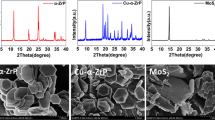Abstract
The aim of this study is to assess the tribological behavior of pure crystalline zinc orthophosphate under boundary lubrication in order to model zinc phosphate-based anti-wear additives. Boundary films were generated from α-Zn3(PO4)2 powder dispersed in poly-alpha-olefin oil, at ambient temperature, by means of a steel sphere-on-flat contact in reciprocating motion. Electrical contact resistance and friction coefficient evolutions enable an understanding of the tribological behavior of crystalline zinc orthophosphate at the sliding interface. A conductive atomic force microscope (C-AFM) equipped with a current sensing setup, Raman spectroscopy, and nano-indentation were used to characterize the resulting film. When involved in a tribological contact, zinc orthophosphate powder forms a continuous patchy adherent film, changing its structure to amorphous orthophosphate, on both sliding steel surfaces. Morphological and mechanical properties of the film are discussed with respect to the ZDTP tribofilm models.










Similar content being viewed by others
References
Spikes, H.: The history and mechanisms of ZDDP. Tribol. Lett. 17, 3 (2004)
Martin, J.M.: Antiwear mechanisms of zinc dithiophosphate: a chemical hardness approach. Tribol. Lett. 6, 1 (1999)
Mosey, N.J., Woo, T.K.: An ab initio molecular dynamics and density functional theory study of the formation of phosphate chains from metathiophosphates. Inorg. Chem. 45, 7464–7479 (2006)
Piras F.M., Rossi A., Spencer N.D.: Combined in situ (ATR FT-IR) and ex situ (XPS) study of the ZnDTP-iron surface interaction. Tribol. Lett. 15, 3 (2003)
Fuller, M., et al.: Chemical characterization of tribochemical and thermal films generated from neutral and basic ZDDPs using X-ray absorption spectroscopy. Tribol. Int. 30, 4 (1997)
Aktary, M., McDermott, M.T., Torkelson, J.: Morphological evolution of films formed from thermooxidative decomposition of ZDDP. Wear 247, 172 (2001)
Minfray, C., et al.: A multi-technique approach of tribofilm characterisation. Thin Solid Films 447–448, 272–277 (2004)
Nicholls, M.A., et al.: Nanometer scale chemomechanical characterization of antiwear films. Tribol. Lett. 17, 205 (2004)
Heuberger, R., Rossi, A., Spencer, N.D.: XPS study of the influence of temperature on ZnDTP tribofilm composition. Tribol. Lett. 25, 185 (2007)
Warren, O.L., Graham, J.F., Norton P.R.: Nanomechanical properties of films derived from zinc dialkyldithiophosphate. Tribol. Lett. 4, 189 (1998)
Bec, S., et al.: Relationship between mechanical properties and structures of zinc dithiophosphate anti-wear films. Proc. R. Soc. Lond. A 455, 4181 (1999)
Yagishita, K., Igarashi, J.: Long drain/fuel efficient engine oils based on the ZDTP substitute additive technology. JSAE 20030320 (2003)
Tsujimoto, T., Yaguchi, A., Yagishita, K.: Operational performance of eco-friendly engine oils formulated with the sulfur free additive ZP. JSAE 20077300 (2007)
Quinn, C.J., Beall, G.H., Dickinson, J.E.: Alkali zinc pyrophosphate glasses for polymer blends. Proc. XVIth Int. Congr. Glass 4, 79 (1992)
Brow, R. K.: Review: the structure of simple phosphate glasses. J. Non-Cryst. Solids 263–264, 1 (2000)
Crisp, S.: Infrared spectroscopic studies on the development of crystallinity in dental zinc phosphate cements. J. Dent. Res. 57, 245 (1978)
Narayanan, S.: Surface pretreatment by phosphate conversion coatings—a review. Rev. Adv. Mater. Sci. 9, 130 (2005)
Martin, J.M., Ohmae, N.: Nanolubricants. Tribology in Practice Series. Wiley (2008)
Belin M.: Triboscopy: a new quantitative tool for microtribology. Wear 168, 7 (1993)
Tonck, A., Martin, J.M., Kapsa, Ph., Georges, J.M.: Mechanical behavior of tribochemical films under a cyclic tangential load in a ball-flat contact. Tribol. Int. 12, 209 (1979)
Houzé, F., Meyer, R., Schneegans, O., Boyer, L.: Imaging the local electrical properties of metal surfaces by atomic force microscopy with conducting probes. Appl. Phys. Lett. 69, 13 (1996)
Weng, D., Jokiel, P., Uebleis, A., Boehni, H.: Corrosion and protection characteristics of zinc and manganese phosphate coatings. Surf. Coat. Technol. 88, 147–156 (1996)
Frost, R.L.: An infrared and Raman spectroscopic study of natural zinc phosphates. Spectrochim. Acta Part A 60, 1439 (2004)
Gauvin, M., et al.: Zinc phosphate chain length study under high hydrostatic pressure by Raman spectroscopy. J. Appl. Phys. 101, 63505-1 (2007)
Belin, M., Martin, J.M.: Triboscopy, a new approach to surface degradations of thin films. Wear 156, 151 (1992)
Gadenne, M., et al.: First AFM observation of thin cermet films close to the percolation threshold using a conducting tip. Physica B 279, 94 (2000)
Demmou, K., Bec, S., Loubet, J.L., Martin, J.M.: Temperature effects on mechanical properties of zinc dithiophosphate tribofilms. Tribol. Int. 39, 12 (2006)
Pethica, J.B., Oliver, W.C.: echanical properties of nanometer volumes of material: use of the elastic response of small area indentations. Mater. Res. Soc. Symp. Proc. 130, 13 (1989)
Hochstetter, G., et al.: Strain rate effects on hardness of glassy polymers in the nanoscale range. Comparison between quasi-static and continuous stiffness measurements. J. Macromol. Sci. Phys. B38(5–6), 681 (1999)
Joly-Pottuz, L., et al.: Diamond-derived carbon onions as lubricant additives. Tribol. Int. 41, 2 (2008)
Tischendorf, B., et al.: A study of short and intermediate range order in zinc phosphate glasses. J. Non-Cryst. Solids 282, 147 (2001)
Tschoegl, N.W. et al.: The effect of temperature and pressure on the mechanical properties of thermo- and/or piezorheologically simple polymeric materials in thermodynamic equilibrium a critical review. Mech. Time-Dependent Mater. 6, 5399 (2002)
Roche, S., et al.: Analysis of the elastic modulus of a thin polymer film. Mater. Res. Soc. Symp. Proc. 778, 11722 (2003)
Georges, J.M., et al.: Mechanism of boundary lubrication with zinc dithiophosphate. Wear 53, 9–34 (1979)
Acknowledgments
Comments from an anonymous reviewer improved the clarity of presentation and are appreciated. The authors thank K. Demmou for performing nanoindentation experiments on the sample. This work was supported by the Région Rhone-Alpes.
Author information
Authors and Affiliations
Corresponding author
Rights and permissions
About this article
Cite this article
Gauvin, M., Dassenoy, F., Belin, M. et al. Boundary Lubrication by Pure Crystalline Zinc Orthophosphate Powder in Oil. Tribol Lett 31, 139–148 (2008). https://doi.org/10.1007/s11249-008-9346-x
Received:
Accepted:
Published:
Issue Date:
DOI: https://doi.org/10.1007/s11249-008-9346-x



